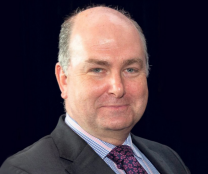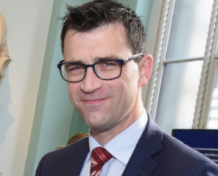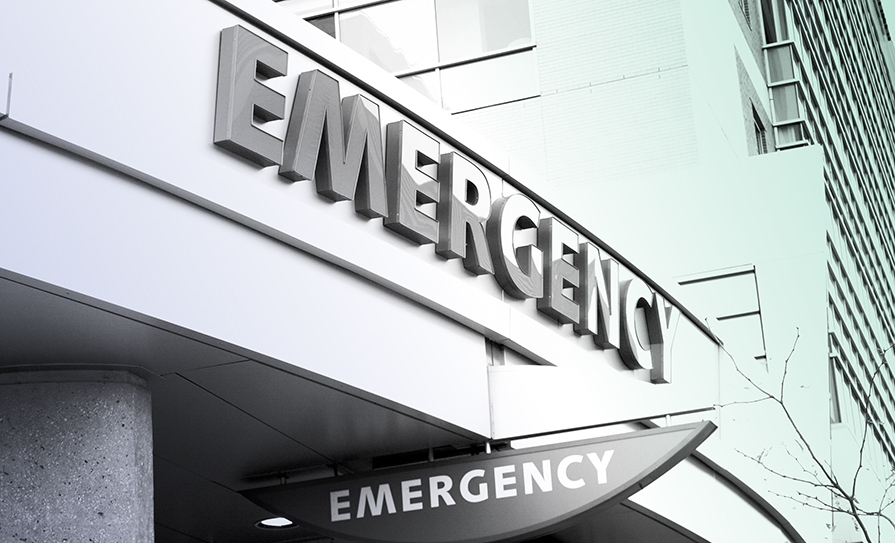With the announcement that the HSE will take a longer-term approach to capacity issues and an updated emergency medicine specialty review due next year, David Lynch looks at current and future challenges facing emergency departments
I’ve had situations where I have patients with open fractures, who I have not been able to move off the ambulance trolley because I have no clinical care space for them,” according to Dr Peadar Gilligan, Consultant in Emergency Medicine (EM) at Beaumont Hospital, Dublin, and former IMO President.

Dr Gilligan delivered a presentation on crowding in emergency departments (EDs) across Ireland at the IMO consultant national meeting in Killarney last month.
“The cost of that, first of all, is it compromises the care I’m delivering to that individual patient,” he stated.
The second cost is that ambulances are not available for the next emergency in the community, he added.
“It’s due to the fact that we don’t have the [bed] capacity in the system. It shouldn’t be allowed to happen,” Dr Gilligan said.
Those working at the frontline of emergency medicine may have emerged from the perennially difficult winter months, but serious challenges remain.
“We can never have another winter like the winter we just had,” Irish Association for Emergency Medicine (IAEM) President Prof Conor Deasy told the Medical Independent (MI). “Our staff are exhausted. We are finding that we are running small hospitals in our emergency departments, in terms of [the number of] patients that are awaiting an inpatient bed.”

We are finding that we are running
small hospitals in our emergency
departments, in terms of [the number of]
patients that are awaiting an inpatient bed
Long-term planning
Prof Deasy, Professor of Emergency Medicine at University College Cork and Clinical Director of Emergency and Acute Care at Cork University Hospital (CUH), noted that the capacity challenges and volume of work is no longer just an issue during the winter months.
“To be fair to the Minister [for Health Stephen Donnelly] he has acknowledged this,” said Prof Deasy, who welcomed the intention to replace the annual winter plans with a “three-to-five-year unscheduled care plan”.
Earlier this month, HSE CEO Mr Bernard Gloster told RTÉ that winter plans to deal with overcrowding “have served their purpose” and that the health service will now focus on more long-term planning. According to Mr Gloster, by June, a three-year plan will be finalised for unscheduled care.
He said it would not solve all of the challenges or “take away all of the difficulty”.
But Mr Gloster argued the longer-term plan “certainly” would “put us in a better position to consistently respond” to challenges in EDs.
It would also allow “the public to understand what exactly the position is that they’re going into and equally important…for our nurses and for other professionals to all fully understand exactly where we’re going, where we’re at, and where we’re trying to get to”.
The IAEM President told MI that “we believe this is a far better way of doing things”. Prof Deasy added that “we are happy that the Minister has changed the focus to three-to-five-year plans”.
“We feel this is more strategic and will give better value as well. Because even with the best will in the world, if you are waiting for the winter plan to be announced and then you are going to the market to recruit whatever is in the winter plan, in terms of bringing on board doctors, nurses, HSCPs [health and social care professionals], administrative staff – you are doing it at the last minute. To try and on-board people across these disciplines takes time. And, usually, the winter is over by the time you on-board the people who have been announced as being funded through the winter plan.”
But what is causing the severe pressures on EDs across the country beyond the traditional seasonal surge during the winter period? Prof Deasy said the problem
is “multifactorial”.
“There is a lack of space in our EDs because admitted patients requiring an inpatient bed are stuck in ED on trolleys for lack of an inpatient hospital bed. In terms of ambulatory patients, EDs have seen an increase in what would have been ordinarily considered primary care activity and they wait for an inordinate amount of time.”
He said that patients are telling EM doctors “that they haven’t alternatives”.
“That they try to access general practice, but the appointments being offered are not immediate, same or following day, and they are concerned enough that they perceive they have to come to the emergency department immediately.”
Prof Deasy added that “our GP colleagues would also say they are overwhelmed”.
“Our population census is at an all-time high. Health anxiety in our population is high. The age profile and medical complexity of our population is high. Health service demand is at an all-time high. It’s a perfect storm. The emergency department is the ‘canary in the mine’ of the overall health system.”
Reflecting on the experience in his own hospital (CUH), Prof Deasy said that “on any given day we will have 60-to-70 admitted patients between the emergency department and the acute medical unit” awaiting an inpatient bed.
Reasons for this include the fact the hospital “is struggling to get patients out the other end of the hospital into rehab community care beds, and long-term care beds”.
He added that, across the system, there needs to be an investment in beds, both in the acute hospital sector, but also in the rehab and community sectors, so that patients can access a bed that is appropriate to their level of need.
“That’s what we are not seeing happen at the moment.”
The lack of bed capacity is a topic that the IAEM has been raising for many years. Prof Deasy thinks it remains the most significant contributor to the difficulties faced
by clinicians and patients in Irish emergency departments.
Minister Donnelly told the joint Oireachtas committee on health at the end of April that “some 261 acute beds and 16 critical care beds are expected… under the capital programme for this year”. The Minister added that in recent years the Government had “added nearly 1,000 extra hospital beds, 410 community beds, and 65 critical care beds…. In addition, I am in discussions with Government colleagues on a proposal to create a rapid-build plan for an additional 1,500 hospital beds around the country.”
However, Prof Deasy said that one of the IAEM’s concerns is that there “has also been closure of beds across the system during this time”.
“There has been a contraction in beds in the community sector – in my area, for example. So, the 1,000 beds that have been put into the system… the benefit of them is not being realised, because there have been changes in community bed availability for acute hospitals to discharge patients to.”
Speaking at the IMO AGM, Dr Gilligan also pointed his finger firmly towards the lack of bed capacity as the chief reason for the enduring difficulties within EDs.
According to Dr Gilligan, the primary cause of the crowding in EDs “is the fact that those patients that we see, who are so sick, so badly injured that they require hospital admission, do not have a bed available to them in a timely manner”.
“As a result, they spend a protracted period of time in the emergency department.”
Dr Gilligan said it is not an issue of “inappropriate attendance” at EDs.
“Because inappropriate attendances we can process quite quickly and we can deliver the prescription they need or the advice that they need and then discharge them home,” he said. “It is actually the appropriate visiting patients that are proving the challenge for us, because they require admission to hospital and we don’t have bed capacity available for them.”
Dr Gilligan said that timely assessment and admission by on-call teams would reduce ED length of stay. There was a need to have more timely availability of laboratory tests and radiology.
He warned that the problem would get worse. He cited Economic and Social Research Institute figures, which project a need for between 4,000 and 6,300 additional beds in public and private hospitals between 2015 and 2030; with up to
5,600 of these projected to be required in public hospitals.
“The impact is clear,” Dr Gilligan told the IMO consultant meeting. “We know from the data… that patients suffering a protracted stay in an emergency department have increased preventable death, increased mortality, increased morbidity; they tend to have a lot longer stay in the hospital as well.”
He noted that there had been “huge developments” in patient care in EM, particularly with presentations such as stroke. However, Dr Gilligan added that “our ability to make that difference is dependent” on timely access to equipment and adequate clinical workspace.
“Crowding ultimately comes down to the length of time that each patient spends in the emergency department and that is the piece we have to address, how we reduce that time for everybody. We need to stop debating it, and actually start delivering those beds.”
Modular builds
Since the AGM last month, the IMO has raised the need for modular builds “to provide additional capacity at hospitals, which are under particular pressure”.
In a statement, the IMO warned that investment in additional hospital beds is not keeping pace with population growth and that the current “dire” situation will worsen unless rapid action is taken.
Prof Matthew Sadlier, Chair of the IMO consultant committee, said: “There is an acute need for 5,000 additional beds if we are to provide adequate care for the population. The dire shortage of beds adds to overcrowding in hospitals and EDs, longer waiting lists and poorer patient outcomes.”
The IMO claimed that international figures show “how far behind Ireland is in terms of bed capacity” compared to other European countries. According to the Organisation, the average in Europe is 3.87 acute beds per 1,000 people whereas in Ireland the figure is just 2.7 beds per 1,000 of the population.
Prof Sadlier continued: “We have to go beyond tinkering with the beds issue. We need urgent action to alleviate crisis points and we need a commitment to a meaningful increase in the number of additional – not replacement – beds. This crisis will persist until we have sufficient beds and doctors to meet the needs of growth in our population and address the complexity of care required.”
Popularity of specialty
Despite the difficulties in the area, emergency medicine remains vibrant and is popular as a specialty among medical students, the IAEM President told MI.
“We find consistently that our core specialty training programme in emergency medicine is oversubscribed,” said Prof Deasy. “Medical students are excited by emergency medicine. They like the diversity of what comes through the door in terms of pathologies, problem solving opportunities; the team work and the high octane excitement of emergency medicine continues to appeal to medical students and junior doctors despite the challenges.”
He also highlighted the continued success of the national SimWars competition. SimWars is an intervarsity simulation resuscitation competition involving medical and nursing students from universities across the island of Ireland, which was launched in 2017.
The 2023 SimWars competition took place in March and was hosted by the RCSI. The all-Ireland contest featured participants from all seven universities on the island with a record 116 medical and nursing students taking part. Representatives from University of Limerick School of Medicine were crowned the winner in what the IAEM described as “one of the most competitive finals in SimWars’ history”.
Staffing EDs into the future
HSE National Doctors Training and Planning (NDTP) published its last specialty specific review for emergency medicine (EM) six years ago. However, the Medical Independent (MI) has been told that the NDTP expects to have specialty workforce plans for the majority of specialties by the end of next year or early 2025.
This will include a re-examination of the previous review of emergency medicine.
“An emergency medicine specialty review was completed in 2017 and will be updated next year (2024),” the HSE spokesperson told MI.
The spokesperson added the NDTP expects to have specialty workforce plans for surgical specialties by the end of 2023/2024 and anaesthesiology by the end of 2023.
At the end of November 2022, there were 153 consultants working in emergency medicine (whole-time equivalents) out of a total of 3,860 consultants, according to the HSE staff census figures.
However, emergency medicine, like all specialties, has been impacted by the ongoing consultant recruitment and retention crisis. Prof Conor Deasy, President of the Irish Association for Emergency Medicine, told MI that crowding in emergency departments and the impact on the ability of doctors to provide the level of care they would like to patients “undermines the ability to recruit and retain staff, stresses and distresses staff, there is no doubt about that”.
However, emergency medicine is primarily based in the public sector and those working in the specialty may find the new consultant contract attractive.
Currently, most EM doctors are on the type A contract (public work) and are also employed on the post-2012 terms and conditions (with the 30 per cent pay cut for ‘new entrants’).
“The new Sláintecare contract will be welcomed, I think, by and large, by emergency medicine consultants,” said Prof Deasy.
“We work these hours anyway [under the new contract] and many of my colleagues are post-2012 [contract], so will see an uplift in their pay cheque as well as an uplift in their CME [continuing medical education] fund. So I think emergency medicine would be one of the groups, like psychiatry, acute medicine, geriatrics, and others, who will see opportunity in the new Sláintecare contract and sign up.”
MI asked the HSE how many consultants have taken up the new contact since it came into force in early March. The HSE said the figures “will be available in due course”. However, the Executive spokesperson added that “a number” of new contracts “have already issued throughout the health services”.
During the height of the winter surge, on 18 January, the Minister for Health Stephen Donnelly told the Dáil that the Government “is rapidly expanding resources within emergency departments”.
“I sanctioned 51 extra emergency medicine consultants last year. That is approximately a 40 per cent increase in the total number. We have launched phase 2 of the safe staffing framework, which increases the number of nurses and healthcare assistants in emergency departments.
“However, as we all know, no additional resource we can put into emergency departments will solve the issue of overcrowding on its own. What we all know is that most of the solutions to the overcrowding in emergency departments lie outside them. That is why we are continuing to invest right across the board so that only those who really need hospital care come to the emergency department and when they do, they get seen quickly. We have added millions of extra hours of home care support. We fully acknowledge that more is needed.”













Leave a Reply
You must be logged in to post a comment.